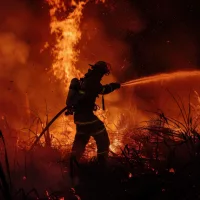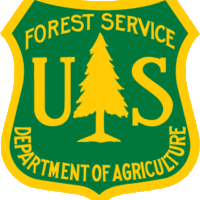
When Oregon’s 2024 fire season ended in late October, over 1.9 million acres had burned across the state – an area larger than Delaware. For Tyler McCarty, district manager at the Coos Forest Protective Association (CFPA), in the coastal southwest part of the state, fires today are a “night and day difference” from what they were twenty years ago.
McCarty spent more than two decades with the Oregon Department of Forestry before starting his current position in rural Coos County, where he also commands one of the state’s incident management teams that responds to large fires and other natural disasters. He started his career right out of high school as an entry level firefighter, and has been fighting fires since 2000.
“When I first started, a two or three thousand acre fire was a big fire,” McCarty told the Daily Yonder. “One of the fires that my incident management team was on this year was 180,000 acres.”
As the Oregon fire season trends longer and fires burn larger, McCarty and others who work with Oregon’s remaining few forest protective associations are grappling with questions about how they will retain personnel and secure enough funding to fight the fires of the future.
“You need more people to manage a 180,000 acre fire versus a 6,000 acre fire, which our system is kind of built on,” McCarty said. “Right now we’re operating in a system with a funding model that doesn’t support the fires that we’re seeing today.”
A Century of Community-Based Forest Protection
The first iteration of the forest protective association in Coos County was organized in 1910. Two years later, in 1912, the Douglas Forest Protective Association (DFPA) formed in the next county over. In those days, the goal was fewer fires and a sense of shared responsibility among those who owned and logged land in Oregon’s forests.
Nowadays, the state of Oregon mandates that private forest landowners – many of whom are in the timber industry – have fire protection. Membership in a forest protective association like the one McCarty leads is one way to meet that requirement.
The state of Oregon provides about 50% of the funding for these associations, according to Patrick Skrip, the district manager at DFPA. The other 50% comes from private and public landowners, such as the Bureau of Land Management and Bureau of Indian Affairs. Currently, Oregon has three forest protective associations that operate with this or a similar funding model.
To the east, Idaho has its own version of community-based forest protection. Called timber protective associations, the state’s two organizations have operated in some form since the early 1900s. At the edge of the Payette National Forest in McCall, Idaho, the Southern Idaho Timber Protective Association protects over half a million acres including private land, state-owned land, and portions of federally-owned land and national forests. In northern Idaho, the Clearwater-Potlatch Timber Protective Association protects nearly one million acres owned by private landowners and state and federal agencies.
As in Idaho, Oregon’s forest protective associations provide fire suppression and prevention services rooted in community partnership. There are no similar protective associations anywhere else in the country.
“It’s a system that’s been in place for over a hundred years, and we believe that the best answers come locally,” Skrip told the Daily Yonder.
This local approach is exemplified by the resources shared between private landowners and their forest protective associations. Ken Canon, the president of the board of DFPA, said it is common practice for landowners to lend firefighting teams their timber equipment like excavators and dozers during a fire.
“The nature of DFPA and the way it’s set up is that they not only value the resource that the landowners own, but they also value the very, very close relationships they have with the landowners,” Canon said.
Canon is a retired attorney who has lived in rural Oregon for most of his life, and in Douglas County for over two decades. The 282 acre parcel of land he owns is part of the 1.6 million acres DFPA manages. Mostly forested, the area makes up some of the most productive timberlands in the lower forty-eight, Skrip told the Daily Yonder. It is also a vital part of the local economy.
In the summer, this same land can pose a significant fire risk. But shutting down timber production, even temporarily, also means shutting down an income stream for local landowners. As a district fire warden, Skrip is one of the people with authority to close the woods for logging activity. It is not a responsibility he takes lightly.
“Those are tough decisions, and I’m very mindful,” Skrip said. “They impact our operator community and our mills, and those are mortgages that people have to pay.”
When Skrip has had to make those tough calls, the larger private landowners have generally supported the decision, Canon said. Many landowners – Canon included – take their own measures when it comes to fire prevention. In Coos County, McCarty said private landowners do the same, from making evacuation plans to ensuring their homes are as defensible for firefighters as possible.
Even with the close cooperation between landowners and their forest protective associations, the increase in bigger fires burning at the same time means resources are stretched thin.
Firefighting Challenges
Ken Canon has a 120º vista from his property, which sits atop a small mountain surrounded on two sides by forest owned by the federal Bureau of Land Management. That land has not been managed in any way for years, Canon said, partly because of efforts to protect the spotted owl that date back to the 1990s. Today, the land is heavily forested as a result.
“It’s pretty dense, and the denser the fire, the more intense they are,” Canon said.
To mitigate against a future fire on the federal lands jumping to his property, Canon has taken to creating a boundary between his property and the federally-owned neighboring land. He said he has taken out the undergrowth on his side of the property line and left the old-growth trees with space between them.
Forest management is just one part of the story when it comes to the kinds of fire blazing in Oregon today. Dense forests like the one bordering Canon’s property are filled with fuels that sustain fires. On the landscape’s other extreme, burn scars from previous fires that have experienced some regrowth also provide what Skrip calls “light and flashy fuel” for fires to consume quickly as they advance.
Climate change is also upsetting conventional methods for fire management. Warmer-than-average temperatures and heat waves during the summer season dry out fuels. Combine this with the state’s current megadrought conditions, which are drier than any other period in the past thousand years, and there is a new host of challenges for fire prevention and suppression efforts.
“In this era of fire, we’ve seen more acres burned in our district in the last 10 years than in the last hundred years combined,” Skrip said. The fire regime is also marching to new lengths, Skrip said, with burning happening more frequently north of Roseburg and in the foothills of the Cascades.
Adam Sinkey, the North Unit Forester for DFPA, started firefighting at seventeen, and has worked his way up the ranks since the early 2000s. During the first half of his career at DFPA, Sinkey said there was one big fire beyond what the district could handle. That was in 2004, and Sinkey said the district’s next big fire after that was in 2013. Now, Sinkey said, those big fires have become commonplace.
“We’ve had one in the district or multiple in the district it seems like every year, or every other year, ever since 2013,” Sinkey said.
Larger and more severe fires strain a system where there are only so many resources to go around. Fires also carry a significant financial burden and put a heavy physical and mental demand on firefighters. McCarty said his team spent 50 days out in the field this past summer. Other teams were out for as long as 60 days.
“That’s a lot of days sleeping in a tent during the summertime, sleeping in the dirt,” McCarty said. Asking firefighters to be away from their families for months on end while working some of the toughest seasons the state has seen risks high rates of burnout. And while both CFPA and DFPA offer wintertime work in the form of co-ops to retain summer employees, the associations still face year-over-year retention challenges.
Sinkey is one firefighter who built his career in part thanks to DFPA’s winter co-op programs. When, after college, he realized he wanted to make firefighting his full-time job, he stayed on throughout the year. Sinkey’s co-op work ranged from supporting fuel reduction in Douglas County – much like what Canon does each year on his own property – to short stints with the Oregon Department of Transportation operating snowplows on state highway mountain passes. Today, Sinkey said around 40 of DFPA’s 100 summertime employees stick around for the winter co-op program.
“Not only are we reducing heavy fuel loads around people’s homes, but it also allows us to retain good folks and good firefighters throughout the years,” Sinkey said.
Still, Skrip and McCarty agreed they could do with even more full-time employees as today’s fires demand additional resources. Year-round employees allow forest protective associations to retain their leadership on the ground. Ultimately, Sinkey said, it’s “boots on the ground” that put out fires.
But shifting the hiring model to have the majority of employees be permanent would require increased funding at the state level.
Finding a New Funding Model
After the catastrophic 2020 Labor Day Fires destroyed more than 1 million acres over the course of a few days in Southern Oregon, 2021 ushered in a series of conversations among the public and the state government about how to better fund firefighting efforts across the state.
In 2024, a large portion of the 1.9 million acres burned were in Eastern Oregon, a predominantly rural region. Canon said he expects there will be talk about the cost of those fires – a staggering $317.5 million across the state – in the 2025 legislative session.
For private landowners and the forest protective associations that provide for them, the price tag is a reminder of the burden that falls on rural communities.
Private landowners who are members of their local forest protective associations pay for their coverage by the acre. Prices have gone up across the board, McCarty said, to the point where fire protection is no longer affordable, particularly for ranchers and grazers whose land generates less profit than timber.
A more holistic approach to funding would include more investment from urban folks, Canon and McCarty said. Already, every Oregonian pays into a general fund that accounts for 50% of the funding that is dispersed to forest protective associations like in Coos and Douglas counties. But a new era of fire demands more financial resources. Canon and McCarty said those cannot come from rural landowners alone, especially when the fires affect everyone.
One idea is to impose a tax on camping equipment or cars, since both are connected to fires and their common causes: fires set from recreation and malfunctions with catalytic converters. Another idea is to raise the state’s income tax to cover the growing costs of fire protection in the state. A task force was organized by Oregon’s governor earlier this year to look at future possibilities for fire funding. Their findings are due before the legislative session begins in February 2025.
Canon said he wants to see more participation from urban areas, where he said the effects of fire are only growing more apparent.
“What we’ve seen in the last 10 years is it’s not fun going to the Shakespearean Festival in Ashland in choking smoke,” he said. “It’s not just a discomfort, but it’s a health risk.”
Julia Tilton wrote this article for The Daily Yonder.















